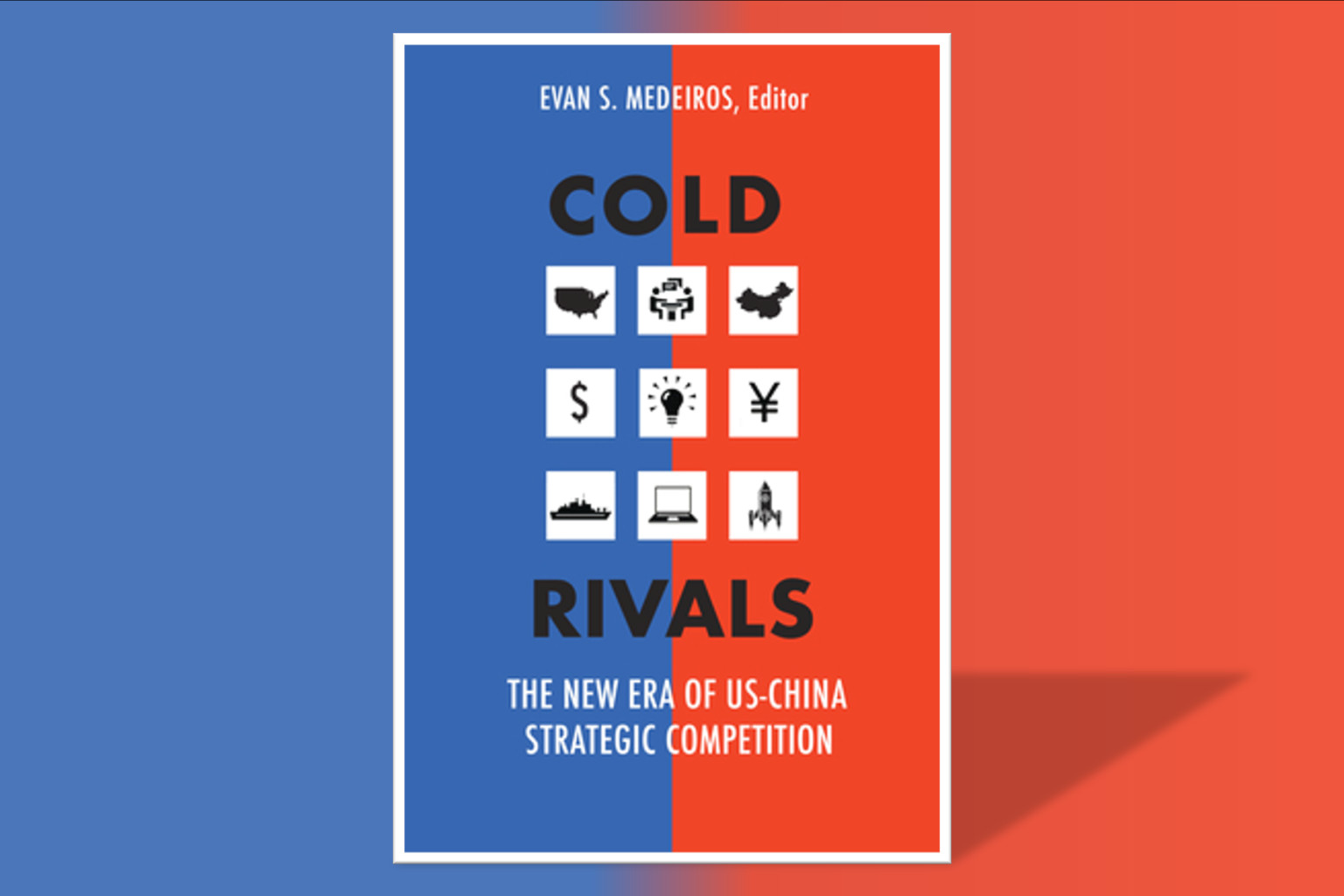Evan S. Medeiros offers a useful collection of essays that examine US-China relations from the 1970s towards our more recent, turbulent days. The defining characterization of US-China relations throughout the book is one of “strategic competition” among rivals. This is a relatively mild, not necessarily warlike, definition. However, as the book editor posits, we are maybe one crisis away from a very different reality between the United States and China (Medeiros, 1), or as Arthur R. Kroeber states, within a stage between the unsustainable and the unachievable (Kroeber, 193).
The book is opened and closed by Medeiros and contains thirteen generally equal-sized chapters, divided into five parts. These chapters are written mostly by American intellectuals but also a few Chinese scholars. The book focuses on the relation between the United States and China since the late 1970s. Over time, the relationship between the two has considerably deteriorated. Crucially, the more recent leaderships of both countries, under Xi Jinping, Donald Trump, and Joe Biden, have not helped to restore friendlier relations.
The History of the Competition
Part one mostly covers the path that was constructed ever since 1972, when the US officially reopened diplomatic relations with the People’s Republic of China. From the initial collection of four essays comes converging views on pivotal moments between the two that have unmoored it: the Tiananmen Square massacre in June 1989; the 1995-1996 Taiwan Strait crisis; the accidental bombing of the Chinese embassy in Belgrade in 1999; the 2001 Hainan Island spy plane incident; and the financial crisis of 2008-2009. Despite high tensions during each crisis, US-China relations were able to withstand them and remained generally amicable during those times.
The book also mentions high points of cooperation, like the US support in the ascension of China to the World Trade Organization (WTO) in 2001 that was reciprocated by China’s anti-terrorism assistance after September 11, 2001. However, these didn’t come without realpolitik motives. In the earlier example, the United States integrated China into the WTO under the façade of friendship, while China never concealed “both ambivalence and discomfort with the liberal order it has joined” (Shambaugh, 376). And for the latter, solidarity was welcome by the hurt United States, but it was also of China’s interest to join forces to prevent terrorist attacks at home. Fast forward in time, the emergence of Xi Jinping, then Donald Trump, and then Joe Biden altogether brought the competition to worrying levels. Xi cracked down at home in China and became assertive externally while US counterparts initiated a trade war and, in a rare bipartisan alignment, converged on a national stance against their Asian rival.
Cold War 1.5
The title of the book—Cold Rivals: The New Era of US-China Strategic Competition—alludes to features of the relationship that resemble the historical Cold War between the United States and Soviet Union (Cold War 1.0). The full materialization of a new Cold War, between the United States and China, is presented as Cold War 2.0. Authors that bring a Chinese perspective to the discussion, Wu Xinbo and Li Chen, posit that to mentalize a Cold War 2.0 between the United States and China is not very appropriate as it might turn out into a self-fulfilling prophecy (Edelstein, 346), whereas others from the opposite spectrum see things differently. Helen Toner observes “some important similarities (a bipolar global system, significant ideological differences, growing mutual suspicion) along with important differences (far greater economic and social interconnection, a lack of clear ideological blocs, much less focus on the threat of nuclear war)” to declare a full “new cold war” (Toner, 320). At which stage US-China relations are at is still up to debate. Shambaugh presented an interesting “Cold War 1.5” definition, characterized by comprehensive competition which exhibits some features of Cold War 1.0 and others that are still premature to be called Cold War 2.0 (Shambaugh, 376).
If what we have is not exactly Cold War 2.0, then why we must be fearful about what can come? Betts sees an economic “Mutually Assured Dependence” (Betts, 56) between the two countries, where the dream of full decoupling would only be achieved at gigantic costs (Kroeber, 193). Military confrontation might be below economic dependence in the general pecking order, but that does not make the case unlikely, because, as stated by Phillip C. Saunders, the United States and China’s weapons are increasingly designed to attack and defend against each other’s systems (Saunders, 215). Even though Medeiros highlights the underappreciated aspects of peoples and behaviors as catalysts for bettering US-China relations, the book generally diverts from these matters and applies a realist lens and points to the harder reality that could likely be a revival of the classic Thucydides Trap.
Whole of Society Approaches
US-China relations have substantially deteriorated in the last few years, as both sides have been employing “whole of society approaches” against each other. From academia to technology to diplomacy, recent domestic legislations have been enacted specifically targeting the other country. This has led to a tit-for-tat approach in external politics. Bilateral meetings, harmless memorandums of understanding, and strategic and economic dialogues between the countries have considerably shrunk in numbers, as presented by some authors. Gridlocked by laws which prevent cooperation, or approximation in many areas. Even collaboration in neutral topics, such as sharing weather data, has diminished (Shambaugh, 370).
Per Paul Triolo and Toner, China’s technological rise has become the single most important point of tension in the bilateral relation. This tension stems from issues such as forced technology transfers, intellectual property theft, and industrial subsidies opening market access for Chinese corporations. Per Mulvenon, the FBI is opening a new China related counterintelligence case about every 10 hours (Mulvenon, 263). Despite objectionable standards used by China in those processes, it is also a reality that the country went from an outsize innovation laggard to a serious challenger, and that bothers and puts the United States on the defensive.
Ideologically, most of the scholars agree that each of the duo’s viewpoint on political freedom has distanced itself from the other in almost irreconcilable ways. Elizabeth Economy regrets that the US policymaking community’s presumption that China’s trajectory would follow that of other previous rapidly growing authoritarian-turned-democratic nations (e.g., Japan, South Korea, and Taiwan) is ill-founded (Economy, 147). In turn, China claims it is simply acting on its three strategic pillars: sovereignty, security, and development (Jisi, 90).
The Future
Amidst growing uncertainty, the future is forecasted contingent to different time horizons (established by the rivals) and scenarios. Edelstein proposes four scenarios: stability restored, competitive coexistence, increased competition, or hegemonic war (Edelstein, 350-353). Edelstein states that key to which of the scenarios prevail are the choices that both rivals make about their involvement in the Russia-Ukraine war. These choices will reflect their own time horizons and intentions of aggression in the near or distant future. Interestingly, he believes that hegemonic war could be more likely in a situation where China invades Taiwan, and the United States shows little opposition to it (Edelstein, 351). And this could be aggravated, according to Betts, by the fact that Taiwan does not enjoy the same sovereign status in international law and diplomatic recognition as Ukraine does (Betts, 62), so practical support from the international community could be less powerful. The scenarios Medeiros predicts are somewhat different: China détente, strained but stable relations, gradual evolution toward an extended rivalry, and outright geopolitical confrontation (Medeiros, 392). Towards the end of the book, authors prescribe solutions to ease tensions, some of which are lessons learned from the US-Soviet experience. As the forecasting essayists posit, communication between the parties is vital to avoid miscalculated consequences, even if it has to be in Cold War 1.0 style “hotlines,” that is direct lines of communication between high authorities (Shambaugh, 377).
In conclusion, the book is an interesting and comprehensive, though sometimes repetitive, work that examines the relation between the United States and China. Analyses are assertive and repetitive, which may come across a little tedious, however on the other hand, it properly portrays a quasi-consensual account of US-China relations through the convergence of similar facts and opinions raised by many of the essayists. Convergence by distinct scholars and thinkers is effective in crystallizing perceptions from both sides. Thus, Cold Rivals: The New Era of US-China Strategic Competition edited by Medeiros serves as a helpful tool for policymakers who deal with US-China relations or other two-country rival dyads.
References
Evan S. Medeiros, ed., Cold Rivals: The New Era of US-China Strategic Competition (Washington DC: Georgetown University Press, 2023)




